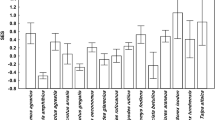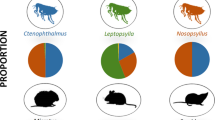Abstract
Parasites often confront conflicting demands when evaluating and distributing themselves among host individuals, in order to attain maximum reproductive success. We tested two alternative hypotheses about host preference by fleas in relation to the age of their rodent host. The first hypothesis suggests that fleas select adult over juvenile rodents because the latter represent a better nutritional resource (the “well-fed host” hypothesis), whereas the second hypothesis suggests that fleas prefer the weaker and less resistant juveniles because they are easier to colonise and exploit (“poorly fed host” hypothesis). We sampled fleas (Synosternus cleopatrae) on the gerbil (Gerbillus andersoni) in 23 different plots in the Negev desert and found an unequal distribution of fleas between adult and juvenile hosts. Furthermore, flea distribution changed as a function of flea density—from juvenile-biased flea parasitism (the “poorly fed host” hypothesis) at low densities to adult-biased flea parasitism (the “well-fed host” hypothesis) at high densities. Other factors that influenced flea preference were soil temperature and the presence of ticks. These results suggest that host selection is not an explicit alternative choice between adults and juveniles (“well-fed host” versus “poorly fed host” hypotheses), but rather a continuum where the distribution between adults and juveniles depends on host, parasite, and environmentally related factors.




Similar content being viewed by others
References
Abramsky Z (1984) Population biology of Gerbillus allenbyi in Northern Israel. Mammalia 48:197–206
Abramsky Z, Rosenzweig ML, Pinshow B, Brown JS, Kotler B, Mitchell WA (1990) Habitat selection: an experimental field-test with two gerbil species. Ecology 71:2358–2369
Anderson RM, May RM (1978) Regulation and stability of host-parasite population interactions. I. Regulatory processes. J Anim Ecol 47:219–247
Buxton PA (1948) Experiments with mice and fleas. I. The baby mouse. Parasitology 39:119–124
Christe P, Moller AP, de Lope F (1998) Immunocompetence and nestling survival in the house martin: the tasty chick hypothesis. Oikos 83:175–179
Christe P, Arlettaz R, Vogel P (2000) Variation in intensity of a parasitic mite (Spinturnix myoti) in relation to the reproductive cycle and immunocompetence of its bat host (Myotis myotis). Ecol Lett 3:207–212
Christe P, Giorgi MS, Vogel P, Arlettaz R (2003) Differential species-specific ectoparasitic mite intensities in two intimately coexisting sibling bat species: resource-mediated host attractiveness or parasite specialization? J Anim Ecol 72:866–872
Cox FEG (2001) Concomitant infections, parasites and immune responses. Parasitology 122:S23-S38
Dawson RD, Bortolotti GR (1997) Ecology of parasitism of nestling American kestrels by Carnus hemapterus (Diptera:Carnidae). Canad J Zool-Revue Canadienne De Zoologie 75:2021–2026
Gandon S, Ebert D, Oliviere I, Michalakis Y (1997) Differential adaptation in spatially heterogeneous environments and host-parasite coevolution. In: Mopper S, Strauss S (eds) Genetic structure and local adaptation in natural insect populations. Chapman and Hall, New York, pp 325–340
Giorgi MS et al. (2004) Causal mechanisms underlying host specificity in bat ectoparasites. Oecologia 138:648–654
Gulland FMD (1995) The impact of infectious diseases on wild animal populations–a review. In: Grenfell BT, Dobson AP (eds) Ecology of infectious diseases in natural populations, vol 1. Cambridge University Press, Cambridge, pp 20–51
Heusner AA (1985) Body size and energy-metabolism. Ann Rev Nutr 5:267–295
Kleiber M (1975) The fire of life: an introduction to animal energetics. Krieger Publishing Company, New York
Kraaijeveld AR, Nowee B, Najem RW (1995) Adaptive variation in host-selection behavior of Asobara tabida, a parasitoid of Drosophila Larvae. Funct Ecol 9:113–118
Krasnov BR, Khokhlova IS, Fielden LJ, Burdelova NV (2001) Effect of air temperature and humidity on the survival of pre-imaginal stages of two flea species (Siphonaptera:pulicidae). J Med Entomol 38:629–637
Krasnov BR, Khokhlova IS, Oguzoglu I, Burdelova NV (2002a) Host discrimination by two desert fleas using an odour cue. Anim Behav 64:33–40
Krasnov BR, Burdelova NV, Shenbrot GI, Khokhlova IS (2002b) Annual cycles of four flea species in the central Negev desert. Med Vet Entomol 16:266–276
Krasnov BR, Khokhlova IS, Fielden LJ, Burdelova NI (2002c) Time of survival under starvation in two flea species (Siphonaptera:Pulicidae) at different air temperatures and relative humidities. J Vector Ecol 27:70–81
Krasnov BR, Khokhlova IS, Shenbrot GI (2003a) Density-dependent host selection in ectoparasites: an application of isodar theory to fleas parasitizing rodents. Oecologia 134:365–372
Krasnov BR, Sarfati M, Arakelyan S, Khokhlova IS, Burdelova NV, A. A. Degen AA (2003b) Host specificity and foraging efficiency in blood-sucking parasite: feeding patterns of the flea Parapulex chephrenis on two species of desert rodents. Parasitol Res 90:393–399
Krasnov B, Khokhlova IS, Burdelova NV, Mirzoyan NS, Degen AA (2004a) Fitness consequences of density-dependent host selection in ectoparasites: testing reproductive patterns predicted by isodar theory in fleas parasitizing rodents. J Anim Ecol 73:815–820
Krasnov BR, Mouillot D, Shenbrot GI, Khokhlova IS, Poulin R (2004b) Geographical variation in host specificity of fleas (Siphonaptera) parasitic on small mammals: the influence of phylogeny and local environmental conditions. Ecography 27:787–797
Lehmann T (1992) Reproductive activity of Synosternus cleopatrae (Siphonaptera, Pulicidae) in relation to host factors. J Med Entomol 29:946–952
Møller AP (1997) Parasitism and the evolution of host life history. In: Clayton DH, Moore J (eds) Host-parasite evolution. General principles and avian models, vol 6. Oxford University Press, New York, pp 105–127
Møller AP (2000) Survival and reproductive rate of mites in relation to resistance of their barn swallow hosts. Oecologia 124:351–357
Marshall AG (1981) The ecology of ectoparasitic insects. Academic Press, London
Mooring MS, Benjamin JE, Harte CR, Herzog NB (2000) Testing the interspecific body size principle in ungulates: the smaller they come, the harder they groom. Anim Behav 60:35–45
Neter J, Kutner MH, Nachtsheim CJ, Wasserman W (1996) Applied linear statistical models, 4th edn. McGraw-Hill Companies, Chicago
Randolph SE (1975) Patterns of distribution of the tick Ixodes trianguliceps Birula on its hosts. J Anim Ecol 44:451–474
Rosa R, Pugliese A (2002) Aggregation, stability, and oscillations in different models for host-macroparasite interactions. Theoret Popul Biol 61:319–334
Rosenzweig ML, Abramsky Z (1985) Detecting density-dependent habitat selection. American Naturalist 126:405–417
Roulin A, Brinkhof MWG, Bize P, Richner H, Jungi TW, Bavoux C, Boileau N, Burneleau G (2003) Which chick is tasty to parasites? The importance of host immunology vs. parasite life history. J Anim Ecol 72:75–81
Simon A, Thomas DW, Blondel J, Lambrechts MM, Perret P (2003) Within-brood distribution of ectoparasite attacks on nestling blue tits: a test of the tasty chick hypothesis using inulin as a tracer. Oikos 102:551–558
Sukhdeo MVK, Bansemir AD (1996) Critical resources that influence habitat selection decisions by gastrointestinal helminth parasites. Internat J Parasitol 26:483–498
Thomas MB, Blanford S (2003) Thermal biology in insect-parasite interactions. Trends Ecol Evol 18:344–350
Thompson PM, Corpe HM, Reid RJ (1998) Prevalence and intensity of the ectoparasite Echinophthirius horridus on harbour seals (Phoca vitulina): effects of host age and inter-annual variability in host food availability. Parasitology 117:393–403
Ulmanen I, Myllymaki A (1971) Species composition and numbers of fleas (Siphonaptera) in a local population of the field vole, Microtus agrestis (L.). Ann Zool Fenn 8:374–384
Valera F, Hoi H, Darolova A, Kristofik J (2004) Size versus health as a cue for host choice: a test of the tasty chick hypothesis. Parasitology 129:59–68
Acknowledgements
Georgy Shenbrot, Amos Bouskila, Ofer Ovadia, Burt Kotler, Jonathan Belmaker, Victor China, and Uri Roll were involved in interesting discussions. We thank Nadezhda Burdelova (Ben-Gurion University of the Negev, Israel), Maria Stanukovich, and Dmitry Apanaskevich (both from Zoological Institute of the Russian Academy of Sciences) for their help in ectoparasite identification. We are grateful to Nivi Kessler, Mariela Liederman, Arnon Tsairi, and Dudi Greenbaum for their invaluable help with all aspects of the study. We also appreciate the thoughtful comments of Jennie McLaren on an earlier version of the manuscript. We thank Lajos Rozsa and two anonymous referees for their helpful comments. Financial support during this study was provided by Ministry of Science, Culture and Sport of Israel (grant 01-18-00331). This is publication no. 186 of the Ramon Science Center and no. 490 of the Mitrani Department of Desert Ecology.
Author information
Authors and Affiliations
Corresponding author
Additional information
Communicated by Roland Brandl
Rights and permissions
About this article
Cite this article
Hawlena, H., Abramsky, Z. & Krasnov, B.R. Age-biased parasitism and density-dependent distribution of fleas (Siphonaptera) on a desert rodent. Oecologia 146, 200–208 (2005). https://doi.org/10.1007/s00442-005-0187-0
Received:
Accepted:
Published:
Issue Date:
DOI: https://doi.org/10.1007/s00442-005-0187-0




